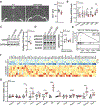Elevated TGFβ signaling contributes to ocular anterior segment dysgenesis in Col4a1 mutant mice
- PMID: 35525525
- PMCID: PMC10410753
- DOI: 10.1016/j.matbio.2022.05.001
Elevated TGFβ signaling contributes to ocular anterior segment dysgenesis in Col4a1 mutant mice
Abstract
Ocular anterior segment dysgenesis (ASD) refers to a collection of developmental disorders affecting the anterior structures of the eye. Although a number of genes have been implicated in the etiology of ASD, the underlying pathogenetic mechanisms remain unclear. Mutations in genes encoding collagen type IV alpha 1 (COL4A1) and alpha 2 (COL4A2) cause Gould syndrome, a multi-system disorder that often includes ocular manifestations such as ASD and glaucoma. COL4A1 and COL4A2 are abundant basement membrane proteins that provide structural support to tissues and modulate signaling through interactions with other extracellular matrix proteins, growth factors, and cell surface receptors. In this study, we used a combination of histological, molecular, genetic and pharmacological approaches to demonstrate that altered TGFβ signaling contributes to ASD in mouse models of Gould syndrome. We show that TGFβ signaling was elevated in anterior segments from Col4a1 mutant mice and that genetically reducing TGFβ signaling partially prevented ASD. Notably, we identified distinct roles for TGFβ1 and TGFβ2 in ocular defects observed in Col4a1 mutant mice. Importantly, we show that pharmacologically promoting type IV collagen secretion or reducing TGFβ signaling ameliorated ocular pathology in Col4a1 mutant mice. Overall, our findings demonstrate that altered TGFβ signaling contributes to COL4A1-related ocular dysgenesis and implicate this pathway as a potential therapeutic target for the treatment of Gould syndrome.
Keywords: Anterior segment dysgenesis; Basement membrane; COL4A1; COL4A2; Gould syndrome; TGFβ; Type IV collagen.
Copyright © 2022 The Authors. Published by Elsevier B.V. All rights reserved.
Conflict of interest statement
Declaration of Competing Interest The authors declare no conflicts of interest.
Figures






Similar articles
-
Elevated TGFβ signaling contributes to cerebral small vessel disease in mouse models of Gould syndrome.Matrix Biol. 2023 Jan;115:48-70. doi: 10.1016/j.matbio.2022.11.007. Epub 2022 Nov 23. Matrix Biol. 2023. PMID: 36435425 Free PMC article.
-
Skeletal pathology in mouse models of Gould syndrome is partially alleviated by genetically reducing TGFβ signaling.Matrix Biol. 2024 Nov;133:1-13. doi: 10.1016/j.matbio.2024.07.005. Epub 2024 Aug 6. Matrix Biol. 2024. PMID: 39097038 Free PMC article.
-
TGFβ Signaling Dysregulation May Contribute to COL4A1-Related Glaucomatous Optic Nerve Damage.Invest Ophthalmol Vis Sci. 2024 May 1;65(5):15. doi: 10.1167/iovs.65.5.15. Invest Ophthalmol Vis Sci. 2024. PMID: 38717426 Free PMC article.
-
COL4A1 and COL4A2 mutations and disease: insights into pathogenic mechanisms and potential therapeutic targets.Hum Mol Genet. 2012 Oct 15;21(R1):R97-110. doi: 10.1093/hmg/dds346. Epub 2012 Aug 21. Hum Mol Genet. 2012. PMID: 22914737 Free PMC article. Review.
-
The expanding phenotype of COL4A1 and COL4A2 mutations: clinical data on 13 newly identified families and a review of the literature.Genet Med. 2015 Nov;17(11):843-53. doi: 10.1038/gim.2014.210. Epub 2015 Feb 26. Genet Med. 2015. PMID: 25719457 Review.
Cited by
-
A multifunction murine Col4a1 allele reveals potential gene therapy parameters for Gould syndrome.J Cell Biol. 2025 Jun 2;224(6):e202409153. doi: 10.1083/jcb.202409153. Epub 2025 Apr 25. J Cell Biol. 2025. PMID: 40279671
-
PI3K block restores age-dependent neurovascular coupling defects associated with cerebral small vessel disease.Proc Natl Acad Sci U S A. 2023 Aug 29;120(35):e2306479120. doi: 10.1073/pnas.2306479120. Epub 2023 Aug 22. Proc Natl Acad Sci U S A. 2023. PMID: 37607233 Free PMC article.
-
Restorative Effects of Synbiotics on Colonic Ultrastructure and Oxidative Stress in Dogs with Chronic Enteropathy.Antioxidants (Basel). 2025 Jun 13;14(6):727. doi: 10.3390/antiox14060727. Antioxidants (Basel). 2025. PMID: 40563358 Free PMC article.
-
Elevated TGFβ signaling contributes to cerebral small vessel disease in mouse models of Gould syndrome.Matrix Biol. 2023 Jan;115:48-70. doi: 10.1016/j.matbio.2022.11.007. Epub 2022 Nov 23. Matrix Biol. 2023. PMID: 36435425 Free PMC article.
-
Collagen IV in Gould syndrome and Alport syndrome.Nat Rev Nephrol. 2025 Jul 31. doi: 10.1038/s41581-025-00982-x. Online ahead of print. Nat Rev Nephrol. 2025. PMID: 40745060 Review.
References
-
- Gould DB, John SW, Anterior segment dysgenesis and the developmental glaucomas are complex traits, Human molecular genetics 11(10) (2002) 1185–93. - PubMed
-
- Sowden JC, Molecular and developmental mechanisms of anterior segment dysgenesis, Eye 21(10) (2007) 1310–8. - PubMed
-
- Ito YA, Walter MA, Genomics and anterior segment dysgenesis: a review, Clinical & experimental ophthalmology 42(1) (2014) 13–24. - PubMed
-
- D’Haene B, Meire F, Claerhout I, Kroes HY, Plomp A, Arens YH, de Ravel T, Casteels I, De Jaegere S, Hooghe S, Wuyts W, van den Ende J, Roulez F, Veenstra-Knol HE, Oldenburg RA, Giltay J, Verheij JB, de Faber JT, Menten B, De Paepe A, Kestelyn P, Leroy BP, De Baere E, Expanding the spectrum of FOXC1 and PITX2 mutations and copy number changes in patients with anterior segment malformations, Investigative ophthalmology & visual science 52(1) (2011) 324–33. - PubMed

